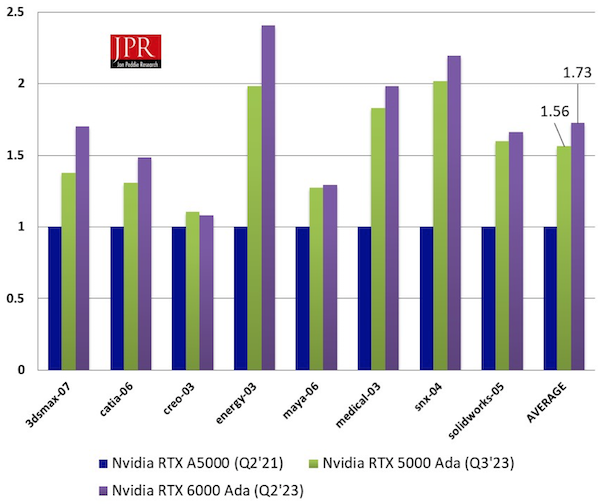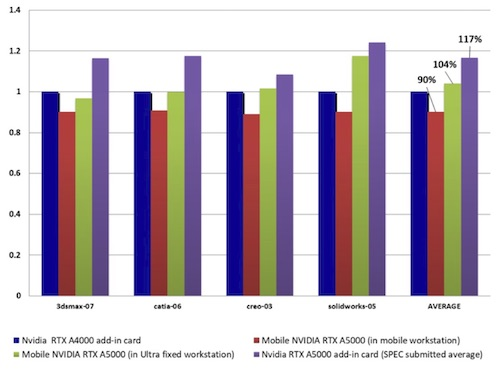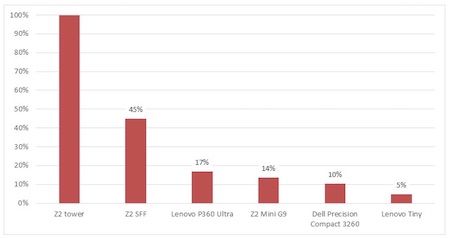NVIDIA has been hogging the spotlight in the world of professional visual computing lately, aggressively rolling out RTX-brand A-series products on the back of its latest Ampere generation technology (covered initially here and fleshed out further here). But while the company dominates the market for professional GPUs, it’s not the only game in town. This month, AMD served notice it remains committed to the demands of applications such as CAD, releasing the first members of a new generation of Radeon Pro products that leverage the advancements of the company’s latest GPU microarchitecture.
The Second-Generation RDNA GPU
When it comes to building a next-generation GPU, there are two basic tools at a chip architect’s disposal: the microarchitecture which typically is upgraded from generation to generation to improve efficiency, along with the periodic ground-up rebuild, and the transistors available, measured in both density and performance. The transistors improve as a function of manufacturing density, albeit allocated at the discretion of the vendor, since bigger chips cost more in both dollars and watt use.
On firm ground with respect to silicon manufacturing, AMD has at its disposal TSMC’s (Taiwan Semiconductor Manufacturing Corp.) 7 nm process, which for all intents and purposes today represents the best transistor density available. The first RDNA 2 chip, the max-capacity flagship “Big Navi” (a.k.a., Navi 21) integrates an impressive 26.8-billion transistors. Bear in mind that typically the biggest, most powerful chip is released first, with trimmed-down lower-cost derivatives following after. That’s precisely what we’re seeing so far in the RDNA 2 generation, with the release of the both workstation-caliber Radeon Pro GPUs as well as the economical Radeon cards designed for gaming.

The first RDNA 2 chip, Big Navi, is built on RDNA 2 with 26.8-billion transistors in 7 nm. (Image source: AMD)
RDNA 2 Upgrades
Let’s look at the new generation’s microarchitecture. As its name might suggest, RDNA 2 is not one of the ground-up rebuilds we occasionally see, but a more modest yet compelling enhancement of the preceding RDNA microarchitecture. There’s one very noteworthy and significant architectural upgrade to RDNA’s core processing Compute Unit (CU) that I’ll cover later in this article. Otherwise, the more important advancement is not so much about the CU’s structure as it is its count, with the max incarnation of Big Navi implementing 80 CUs (and different SKUs exposing 80 or fewer). Second generation optimizations on the mature 7 nm process also brought clock rates up as well in excess of 2GHz internally, and the combination delivers on the overall CU throughput improvement.
Infinity Cache
From an implementation standpoint, the most significant departure (and step forward) I see in RDNA2 is its Infinity Cache. Based on the L3 cache gleaned from the company’s Zen 3 CPU core, the Infinity Cache delivers 128MB of on-chip memory. That ample size operating at fast internal rates allowed AMD engineers to drop the external memory interface from the typical 384 bit width down to 256 bits. The combination of Infinity Cache and the narrower interface allows Big Navi to deliver 2X the bandwidth of a conventional 384-bit GDDR6 interface.
Why not just leverage the benefits of more cache and keep the wider interface to get that much more bandwidth? In one word, power. Big Navi, along with all high performance GPUs today, bumps up against practical power limits, both in terms of supplying the power and dissipating the resulting heat. 250 to 300 watts tend to be the range vendors don’t want to exceed. Even with the narrow interface, Big Navi uses 250 watts. Clearly, the Infinity Cache was a favored solution both for performance and power reduction, and retaining the wider external interface would simply push power consumption too far.

RDNA 2’s Infinity Cache allows AMD to double the bandwidth of a conventional 384b GDDR6 interface, while cutting a bit of power. (Image source: AMD)
All told, AMD promises RDNA2 will roughly deliver 79% higher relative performance (across SKUs), and by combining the increase in performance while cutting and/or maintaining power limits, the company also claims a 54% improvement in Big Navi’s performance/watt, as compared to first generation RDNA.
What About Ray Tracing?
3D graphics remains the foundation of professional visual computing, as much as in CAD spaces as anywhere else. And while it will likely remain the mainstay of CAD visuals for some time, AMD’s rival NVIDIA is betting that physically based rendering will represent the long term future for 3D, both with respect to modeling and gaming. It’s made that position clear and aggressive, as evidenced by its introduction of ray tracing acceleration with 2018–19’s Turing — and affirmed with 2020’s Ampere. I am a believer in the long-term push toward enabling pervasive rendering, and as more CAD users experience the superior visuals — more frequently and with finer level of detail — I imagine there will be more than a few converts among the AEC, manufacturing, and design communities. (For a more detailed dive into the fundamental differences in 3D rendering versus 3D graphics, check out my previous column covering the launch of RTX in NVIDIA’a Volta generation GPU, as well as this follow-on introducing RT cores in Turing, the successor to Volta and predecessor to Ampere. )

There really is no substitute for physically based rendering when conveying the ultimate look and feel of a design. (Image source: AMD, produced with ProRender)
With NVIDIA driving the GPU market, particularly among professional-focused GPUs serving CAD applications, AMD needed to provide some ray tracing oomph in its next generation hardware. And, it has.
Let’s circle back to my earlier reference to RDNA 2’s improvement to its core Compute Unit (CU). The most notable upgrade is the addition of one Ray Accelerator (RA) per CU. Similar to the purpose behind NVIDIA’s RT Core, the RA handles the more cumbersome and compute-intensive calculation for intersecting rays and surfaces, a critical performance path in the overall rendering workload. The ability to fire more rays and trace their path through the 3D scene should mean significantly higher throughput. I have not (yet) had the chance to quantitatively compare rendering throughput in a meaningful way, but AMD’s inclusion of dedicated hardware should make RDNA 2 generation GPU ray tracing performance competitive.
Beyond ray tracing performance throughput, it’s worth focusing attention on another GPU metric that can make or break the proposition of more pervasive rendering, and that’s GPU memory. Rendering not only demands more local memory to keep performance up at similar scene complexity than 3D graphics, it performs very poorly when memory capacity falls short, in fact it falls off a cliff. That’s where the W6800’s 32 GB memory size should fare very well in rendering applications, even compared to NVIDIA’s new RTX A5000 with 24GB (the two with expected pricing in the same rough ballpark).
Of course, hardware features without software support don’t mean much. Supporting the RA functionality, as well as other recent value-add GPU features such as Variable Rate Shading (in NVIDIA’s GPUs as well as Radeon), AMD is leaning on Microsoft’s DirectX 12 Ultimate, which exposes ray-tracing to applications, and its own ProRender SDK. Popular CAD applications currently support ProRender plug-ins, including SOLIDWORKS Visualize, Autodesk Maya and 3ds max, PTC Creo, and Unreal Engine. The latter has its roots in gaming but is being picked up more frequently among professional applications as well.
RDNA2 comes to Radeon Pro: the W6800 and W6600
With RDNA 2 already out in silicon driving AMD’s Radeon gaming-focused products, it was simply a matter of time before it would make its appearance bearing the Radeon Pro brand targeting visual computing professionals, including the CAD community. This month, the company launched its first two Radeon Pro GPUs, the ultra-high end W6800 selling for around $2,250, and the mid-range W6600 priced around $649.
Targeting different ends of the market, the two rely on different RDNA 2 chips. The W6800’s hefty performance, power (250 watts), graphics memory (32GB), and price warranted use of the flagship Big Navi. But at a far more modest price point, the W6600 demanded a more svelte GPU chip, instead opting for Big Navi’s cost-reduced younger sibling, Navi 23, with less than half the flagship’s on-chip resources and one quarter (8 GB) of the graphics memory.

Specifications for Radeon Pro W6800 and W6600. (Source: AMD)

The ultra-high-end AMD Radeon Pro W6800, priced at about $2,250. (Image source: AMD)
You might notice that I introduced the Big Navi chip upfront with 80 compute units and sibling Navi 23 with 32 compute units. You might also have spotted that the W6800 built on Big Navi specifies 20 fewer CUs, and the W6600 built on Navi 23 specs four fewer. Those discrepancies are not a result of typos but rather reflect how vendors fill out a wider range of card-level products with fewer core silicon chips. In the case of the W6800, AMD disables 20 of Big Navi’s 80 CUs and four of the Navi 23’s 32 CUs in a move that can often save chip cost by improving production yield. Chip designers often create the ability for the chip to still function if some portion of its core engines fail due to production defects (which are minimized but never fully eliminated). That allows the vendor to either salvage the chip for a lower performance, lower-price SKU or intentionally cripple a fully functional chip to populate a lower tier card, if necessary.
As such, those reduced-count CU totals also suggest the possibility that AMD may offer future Radeon Pros positioned a notch above the W6800 (with full exposure of Big Navi’s 80 CUs) or just below the W6600 (with fewer Navi 23 CUs enabled). The latter could bring RDNA 2’s entry price to an even more attractive point.
Benchmarks To Come
I was hoping to benchmark the W6800 in context to with the goal of making some sensible judgments on the performance and price/performance, but for the time being — meaningful comparisons weren’t possible. Normally, I would compare a new generation GPU against its predecessor at around the same price point. Or if one vendor's GPU lines up reasonably well with a rival product’s price point and launch date, I could make that contrast as well. For this write-up, neither was readily available. The nearest-match predecessor in AMD’s portfolio is the Radeon Pro VII, launched in 2020, and the closest current NVIDIA rival offering would the RTX A5000, neither of which I’ve had a chance to review.
I hope to better test the merits of the RDNA 2’s improvements, which look intriguing from the perspective of microarchitecture and specifications. For now, I’ll note that — with the above disclaimer considered — the results running SPECViewperf 2020 on the W6800 suggest its raw 3D graphics performance on the order of a meaningful 75–100% higher than the Radeon Pro VII’s predecessor, the now-four-year-old Radeon Pro WX 9100 (with a similar price point at launch). Stay tuned (hopefully) for more quantitative analysis of the Radeon Pro W6000 series’ performance advancements.
Expect RDNA 2 Technology to Offer More Economical Options for Mainstream CAD
AMD’s resurgence in CPUs over the past few years has been a dramatic one. Riding the momentum of both its Zen processor microarchitecture and a fortuitous advantage in manufacturing — courtesy TSMC — the company has not only matched long-time processor rival Intel, in some respects (e.g., core counts) it has pushed past. AMD would love to experience a similar resurgence in professional GPUs, as sales of the company’s Radeon Pro line is lagging far behind NVIDIA’s Quadro line (recently re-branded to simply RTX) targeting professional 3D computing.
RDNA 2 generation Radeon Pro is the tool AMD hopes can kickstart some positive momentum. Selling at around $2,250, the Radeon Pro W6800 sits high on the market’s price curve, beyond the reach of many CAD pros (though you might be surprised at how well NVIDIA’s RTX 5000, 6000, and 8000 series GPUs sell, and at price points well above AMD’s W6800). The W6800 will find homes among the most demanding applications, but with the its $649 launch price (and on the street will likely sell for less), the W6600 will pique more practical interest. It comes in at a price well below NVIDIA’s RTX 4000 series and more on par with its rival’s 2000 series cards that have yet to get an RTX (ray-tracing) upgrade. (The RTX 3000 exists in mobile form factors, not currently for deskside workstations.) At least for now, the W6600 offers AEC and product design types with more mid-size budgets to dip their toes into the world of GPU accelerated rendering.
Finally, keep an eye out for RDNA 2’s progression over time, as the lower end of AMD’s Radeon Pro will hopefully benefit from a trickle-down of the latest generation technology. As it does, Radeon Pro can help CAD users better address their 3D visualization demands — demands that increasingly encompass rendering in addition to tried-and-true interactive 3D graphics. And hopefully for the company’s sake, this latest generation will help re-establish AMD’s competitive positioning in the professional GPU market.
Alex Herrera
With more than 30 years of engineering, marketing, and management experience in the semiconductor industry, Alex Herrera is a consultant focusing on high-performance graphics and workstations. Author of frequent articles covering both the business and technology of graphics, he is also responsible for the Workstation Report series, published by Jon Peddie Research.
View All Articles





Share This Post